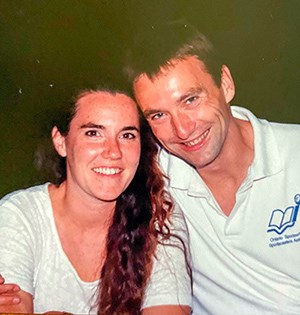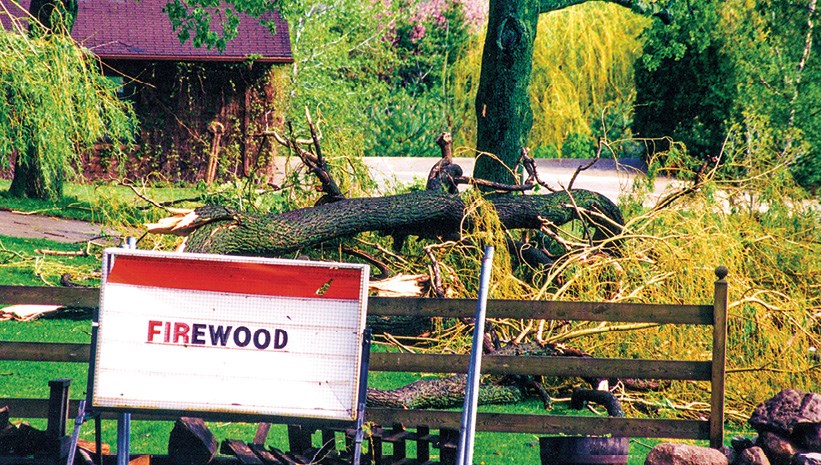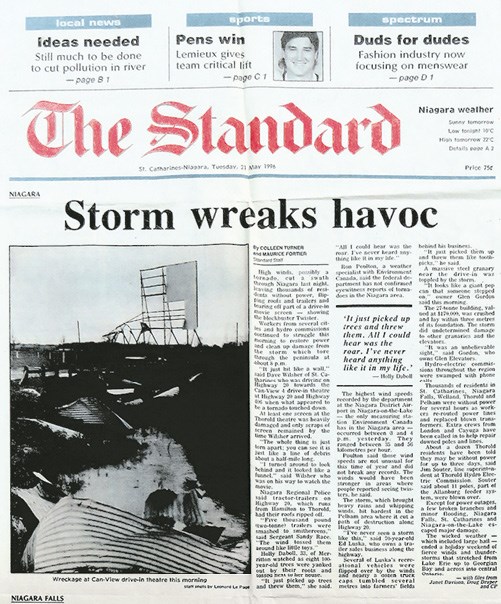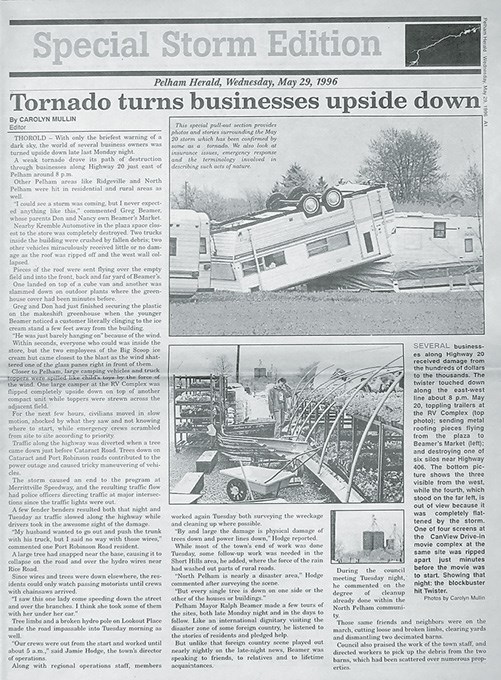If we can't be first, let's be best, recalls former Pelham Herald editor
While initially disappointed that we had missed the fireworks on Victoria Day in 1996, the storm that ripped through Pelham that night gave us more adventure than anyone had bargained for.
My husband Bernie and I, having a rare day off from our jobs at Niagara newspapers (mine as editor of the Pelham Herald), decided to take the drive to Niagara-on-the-Lake to catch the fireworks at the Virgil Stampede. We had seen a flyer somewhere that week — there being no website, Tweets, Facebook events, or Instagram posts to provide the salient details — but we were mistaken on the timing. The fireworks had gone off spectacularly the night before.

Back at home, sitting on the front porch of our home in downtown Fonthill, we chatted about the vacation adventures to come in our first summer as a married couple, plotting and planning on just how much camping gear we could fit into the bed of the new (to us) Ford Ranger in the driveway. We were marveling at how much beautiful blue, pink and white light still remained in the sky shortly before 8 PM, when that same sky turned almost immediately black. Thunder rumbled, lightning cracked, and a downpour arrived minutes later. We heard a loud bang — the sound you hear when a transformer blows — so naturally our power went out, followed quickly by the sounds of multiple sirens around town.
RELATED: The 1996 Pelham tornado that became an urban legendJournalistic instincts took over as we grabbed notebooks and our own camera—my work camera was locked safely away in the newspaper office at the corner of Highway 20 and Pelham Street—and jumped in that new pickup for a drive around. With a tree down on Port Robinson (the source of our power outage) our path to the east was blocked, even as we kept hearing more sirens from that direction. Heading over to Highway 20, we again found the road blocked at Rice Road, later learning trees had come down near Cataract Road and even further east near Pleasantview Memorial Gardens.

We tried snapping a few photos, but while the rain had stopped and the sky’s lightning show was settling down, true darkness was now upon us, and we were not able to get very far without being blocked by emergency vehicles (rightly so). We decided to call it quits and head out again in the morning. By today’s standards of citizen journalism and online immediacy, this seems like an amazingly lame response to on-the-spot news, doesn’t it? Without any outlet for publishing, though, this type of live news was something left to the big outlets — television stations or radio stations with proper recording equipment to capture and disseminate the story.
While our publishing company had been working on a website, it wasn’t yet live, and it was going to be a static landing page in any event. I was ten years away from even starting a Facebook account, and other social media was in its infancy or non-existent. Besides, I reasoned, with a weekly newspaper already laid out, and printing set to take place the next day, I wasn’t able to publish anything for another whole week anyway.

Driving around Tuesday morning, snapping photos of the damage and talking to business owners and property owners, the idea of a special section started to take hold. If the other news outlets were beating us to the spot news coverage, why not take our time, and provide some extra — and hopefully useful — content for readers? The publisher liked the idea, and we set about putting it together. By we, I mean me (with a few shots from Bernie), as the lone paid writer at the Herald.
Yet at the same time, I wasn’t alone. Community connections came through with regular phone-in updates to the office on how people had fared, or how people were starting the recovery, after this freak storm. Several Highway 20 businesses seemed hardest hit. The Can-View Drive-in story was already taking hold — you know, the urban legend that the movie Twister was playing on the only screen at the four-plex that was damaged. While one of the screens was damaged, and Twister was scheduled to screen that night, it wasn’t on that screen, and no movies had started by 8 — sufficient cinematic darkness had not yet descended, funnel clouds notwithstanding.
Property owners snapped photos and brought them in. A former schoolmate working on the spiritual staff at Fonthill United Church offered to write a column on how one’s sense of faith intersects with such trials. And local historian Asa Hansler was quick to inform us that this storm followed an established pattern of storms every 102 years in the town. His call to the paper’s office also turned into a contributed column.
The other informative pieces came together easily enough with stories around insurance claims after damaging storms, on the Town’s emergency response plan, and information about how first responders had been kept busy throughout the night and into Tuesday. After seeing recreational vehicles turned upside down, barns completely destroyed and a few other collapsed roofs, we were all immensely relieved to hear there were no significant injuries reported anywhere that night.

When planning the layout, it was clear that community spirit and resilience would take centre stage in the four-page section, with a story on how North Pelham’s residents spent the rest of the week moving from property to property, clearing debris and branches near houses, churches and farms, and assisting the farmers on Metler Road whose historic barns were leveled.
Luckily, because we used our own camera for some of the shots, those photos survived and, because of a pandemic project cleaning up part of our basement — in the same home that was new to us back in 1996 — I was certain I would be able to locate them for this recollection. I did, in a roll that also contained images of Bernie standing beside his shiny red truck. (It ended up being the perfect vehicle for our trip down east later that summer, in case you’re wondering. Of course, the two-seater no longer fit our lifestyle when we became a family of three a few years later. But that’s another story.)

The photos I captured on my work camera, on the other hand, were on black and white film that I bought in bulk and processed as negatives without prints in a makeshift darkroom in the Herald’s damp basement. Since the parent company closed the paper at the end of that same year, those negatives are long, long gone. Of course, with the end of that chapter came the birth of the Voice as an independent, award-winning community-owned publication — one of the few still in existence today.
Looking back, our preference for telling stories of community positivity, celebrating those who give of themselves for others, shines through in that four-page special section. Rather than focus squarely on what was gone, we put a spotlight on help and hope in times of trial. And if you happened to keep a copy of that section, or have seen a copy some time in your own past, you will note that the last article on the bottom of page 4, is a short but heartfelt submission from the Daboll families, expressing thanks for the many offers of help: “Pelham truly is a caring community,” they wrote.
I agree. Today no less than yesterday. ◆



